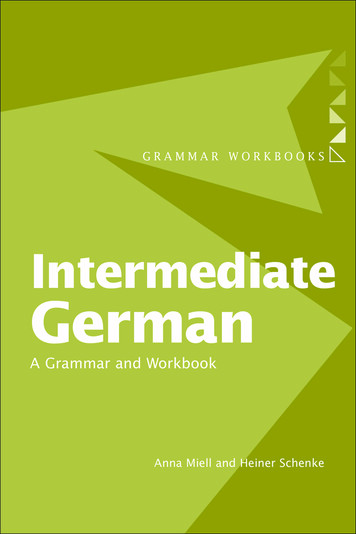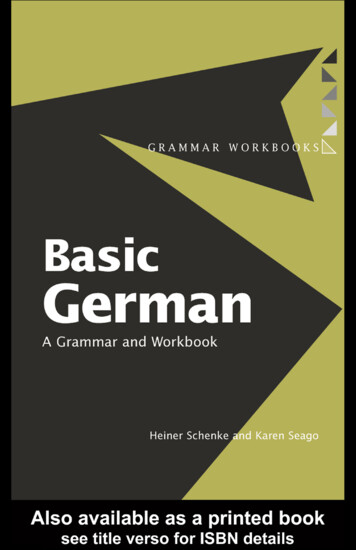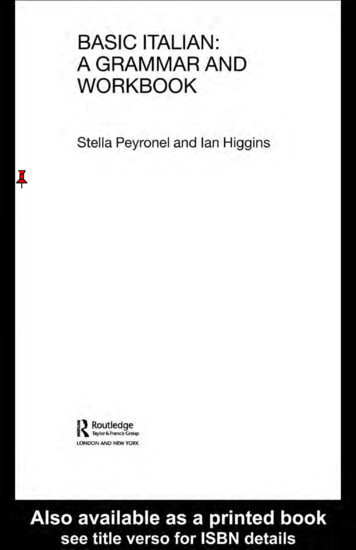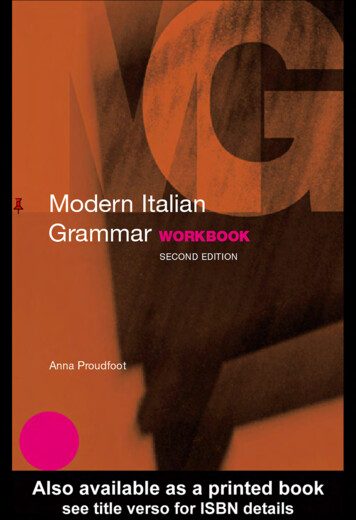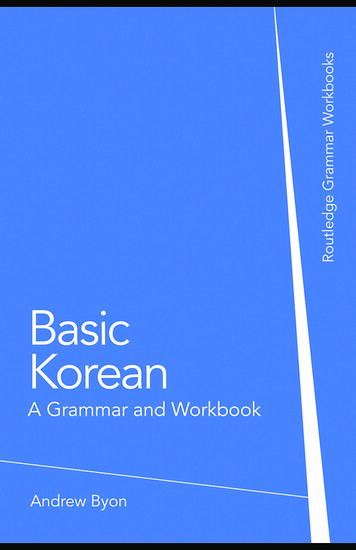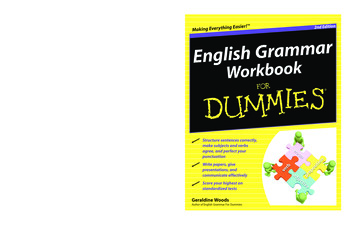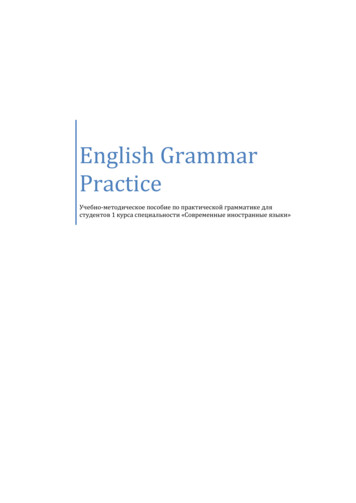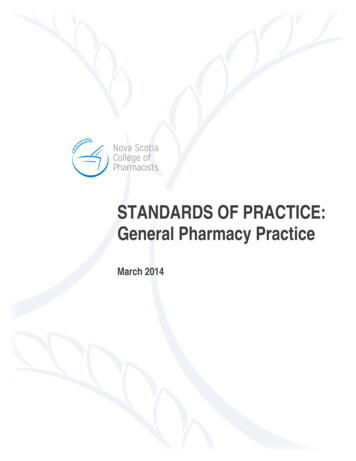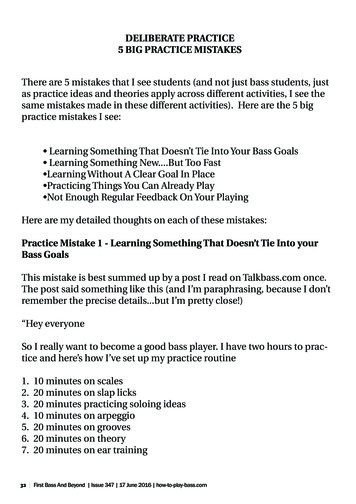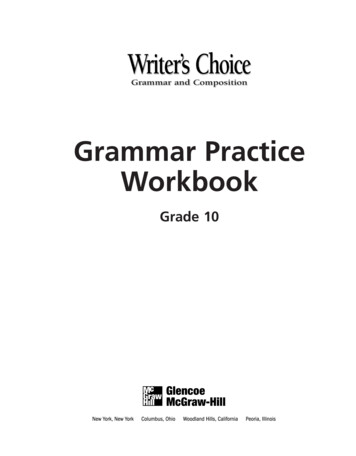
Transcription
Grammar and CompositionGrammar PracticeWorkbookGrade 10
Glencoe/McGraw-HillCopyright The McGraw-Hill Companies, Inc. All rights reserved. Permission isgranted to reproduce material contained herein on the condition that such material bereproduced only for classroom use; and be provided to students, teachers, and familieswithout charge; and be used solely in conjunction with Writer’s Choice. Any otherreproduction, for use or sale, is prohibited without written permission of the publisher.Printed in the United States of America.Send all inquiries to:Glencoe/McGraw-Hill8787 Orion PlaceColumbus, Ohio 43240ISBN 0-07-823356-91 2 3 4 5 6 7 8 9 055 04 03 02 01 00ii
ContentsUnit 10Parts of Speech10.110.210.310.310.410.510.610.7Unit 11Parts of the Sentence11.311.511.511.5Unit 12Prepositional Phrases . . . . . . . . . . . . . . . . . . . . . . . . . . . . . . . . . . . . . . . . . . 13Appositives and Appositive Phrases . . . . . . . . . . . . . . . . . . . . . . . . . . . . . . . 14Participles and Participial Phrases . . . . . . . . . . . . . . . . . . . . . . . . . . . . . . . . 15Gerunds and Gerund Phrases. . . . . . . . . . . . . . . . . . . . . . . . . . . . . . . . . . . . 16Infinitives and Infinitive Phrases . . . . . . . . . . . . . . . . . . . . . . . . . . . . . . . . . 17Clauses and Sentence Structure13.1, 313.513.613.713.813.913.10Unit 15Compound Subjects and Predicates . . . . . . . . . . . . . . . . . . . . . . . . . . . . . . . . 9Indirect Objects. . . . . . . . . . . . . . . . . . . . . . . . . . . . . . . . . . . . . . . . . . . . . . . 10Object Complements . . . . . . . . . . . . . . . . . . . . . . . . . . . . . . . . . . . . . . . . . . 11Subject Complements . . . . . . . . . . . . . . . . . . . . . . . . . . . . . . . . . . . . . . . . . . 12Phrases12.112.212.312.312.3Unit 13Nouns . . . . . . . . . . . . . . . . . . . . . . . . . . . . . . . . . . . . . . . . . . . . . . . . . . . . . . . 1Interrogative and Relative Pronouns. . . . . . . . . . . . . . . . . . . . . . . . . . . . . . . . 2Action Verbs and Verb Phrases . . . . . . . . . . . . . . . . . . . . . . . . . . . . . . . . . . . . 3Linking Verbs. . . . . . . . . . . . . . . . . . . . . . . . . . . . . . . . . . . . . . . . . . . . . . . . . . 4Adjectives . . . . . . . . . . . . . . . . . . . . . . . . . . . . . . . . . . . . . . . . . . . . . . . . . . . . . 5Adverbs . . . . . . . . . . . . . . . . . . . . . . . . . . . . . . . . . . . . . . . . . . . . . . . . . . . . . . 6Prepositions . . . . . . . . . . . . . . . . . . . . . . . . . . . . . . . . . . . . . . . . . . . . . . . . . . . 7Subordinating Conjunctions. . . . . . . . . . . . . . . . . . . . . . . . . . . . . . . . . . . . . . 8Main Clauses; Simple and Compound Sentences . . . . . . . . . . . . . . . . . . . . 18Adjective Clauses. . . . . . . . . . . . . . . . . . . . . . . . . . . . . . . . . . . . . . . . . . . . . . 19Adverb Clauses . . . . . . . . . . . . . . . . . . . . . . . . . . . . . . . . . . . . . . . . . . . . . . . 20Noun Clauses . . . . . . . . . . . . . . . . . . . . . . . . . . . . . . . . . . . . . . . . . . . . . . . . 21Four Kinds of Sentences . . . . . . . . . . . . . . . . . . . . . . . . . . . . . . . . . . . . . . . . 22Sentence Fragments. . . . . . . . . . . . . . . . . . . . . . . . . . . . . . . . . . . . . . . . . . . . 23Run-on Sentences . . . . . . . . . . . . . . . . . . . . . . . . . . . . . . . . . . . . . . . . . . . . . 24Verb Tenses and Voice15.215.415.7Regular and Irregular Verbs . . . . . . . . . . . . . . . . . . . . . . . . . . . . . . . . . . . . . 25Perfect Tenses . . . . . . . . . . . . . . . . . . . . . . . . . . . . . . . . . . . . . . . . . . . . . . . . 26Voice of Verbs . . . . . . . . . . . . . . . . . . . . . . . . . . . . . . . . . . . . . . . . . . . . . . . . 27iii
ContentsUnit 16Subject-Verb Agreement16.216.4–5Unit 17Using Pronouns Correctly17.117.217.317.517.6Unit 18Capitalization of Sentences . . . . . . . . . . . . . . . . . . . . . . . . . . . . . . . . . . . . . . 38Capitalization of Proper Nouns and Proper Adjectives . . . . . . . . . . . . . . . . 39Punctuation, Abbreviations, and 921.1021.1121.12–13ivIrregular Comparisons . . . . . . . . . . . . . . . . . . . . . . . . . . . . . . . . . . . . . . . . . 35Incomplete Comparisons . . . . . . . . . . . . . . . . . . . . . . . . . . . . . . . . . . . . . . . 36Misplaced and Dangling Modifiers. . . . . . . . . . . . . . . . . . . . . . . . . . . . . . . . 37Capitalization20.120.2–3Unit 21Case of Personal Pronouns . . . . . . . . . . . . . . . . . . . . . . . . . . . . . . . . . . . . . . 30Pronouns with and as Appositives . . . . . . . . . . . . . . . . . . . . . . . . . . . . . . . . 31Pronouns After Than and As . . . . . . . . . . . . . . . . . . . . . . . . . . . . . . . . . . . . 32Pronoun-Antecedent Agreement . . . . . . . . . . . . . . . . . . . . . . . . . . . . . . . . . 33Clear Pronoun Reference . . . . . . . . . . . . . . . . . . . . . . . . . . . . . . . . . . . . . . . 34Using Modifiers Correctly18.218.418.7Unit 20Agreement with Linking Verbs . . . . . . . . . . . . . . . . . . . . . . . . . . . . . . . . . . . 28Agreement with Special Subjects . . . . . . . . . . . . . . . . . . . . . . . . . . . . . . . . . 29End Punctuation . . . . . . . . . . . . . . . . . . . . . . . . . . . . . . . . . . . . . . . . . . . . . . 40The Colon . . . . . . . . . . . . . . . . . . . . . . . . . . . . . . . . . . . . . . . . . . . . . . . . . . . 41The Semicolon. . . . . . . . . . . . . . . . . . . . . . . . . . . . . . . . . . . . . . . . . . . . . . . . 42Commas and Coordinate Adjectives. . . . . . . . . . . . . . . . . . . . . . . . . . . . . . . 43Commas and Compound Sentences. . . . . . . . . . . . . . . . . . . . . . . . . . . . . . . 44Commas with Parenthetical Expressions and Conjunctive Adverbs . . . . . . 45Commas with Direct Address and Tag Questions . . . . . . . . . . . . . . . . . . . . 46Misuse of Commas . . . . . . . . . . . . . . . . . . . . . . . . . . . . . . . . . . . . . . . . . . . . 47The Dash . . . . . . . . . . . . . . . . . . . . . . . . . . . . . . . . . . . . . . . . . . . . . . . . . . . . 48Quotation Marks. . . . . . . . . . . . . . . . . . . . . . . . . . . . . . . . . . . . . . . . . . . . . . 49Italics (Underlining) . . . . . . . . . . . . . . . . . . . . . . . . . . . . . . . . . . . . . . . . . . . 50The Apostrophe. . . . . . . . . . . . . . . . . . . . . . . . . . . . . . . . . . . . . . . . . . . . . . . 51Hyphens and Abbreviations . . . . . . . . . . . . . . . . . . . . . . . . . . . . . . . . . . . . . 52
Grammar PracticeName . Class . Date .10.1NounsKey InformationA noun names a person, place, thing, or idea.A concrete noun names an object that canbe recognized by any of the senses; anabstract noun names an idea, a quality,or a characteristic.A proper noun names a particular person,place, thing, or idea; a common noun is thegeneral name of a person, place, thing, or idea.A collective noun names a group and can beregarded as either singular or plural. A. Identifying NounsUnderline the nouns in the following sentences.1. During the early years of the United States, thousands of settlers traveled west to buildnew homes.2. Women and men worked together to clear the land, plant crops, and build homes.3. Besides this work, women tended the children and did housekeeping chores.4. They prepared food to use during the winter.5. They made clothes for the whole family and used homemade soap to wash the laundry.6. A frontier mother was often the only teacher her children had.7. Because there were few doctors, women had to take care of the medical needs oftheir families.8. Settlers usually lived so far apart that isolation was a common problem.Copyright The McGraw-Hill Companies, Inc.9. Sometimes pioneer families became friends with Native Americans who lived nearby.10. To help fight loneliness, many women wrote journals and diaries about their livesand experiences. B. Identifying Noun TypesFrom the nouns you identified in the sentences above, list an example for each type of noun.Possible answers are given.familyCollective nounisolation, lonelinessAbstract nounwomen, land, United StatesConcrete nounyears, settlers, journalsCommon nounUnited States, Native AmericansProper nounWriter’s Choice: Grammar Practice Workbook, Grade 10, Unit 101
Grammar PracticeName . Class . Date .10.2Interrogative and Relative PronounsKey InformationQuestions are formed with interrogativepronouns.who whom whose which whatWho is coming to dinner?Whose keys are these?A relative pronoun is used at the beginning ofa special group of words that contains its ownsubject and verb and is called a hichwhicheverwhatwhateverThe woman who won the marathon is 35.Whoever works hardest will get promoted. A. Distinguishing Between Interrogative and Relative PronounsUnderline the pronoun in each of the following sentences. Then write whether the pronoun isinterrogative or relative.interrogative1. Who finally auditioned for the lead role?2. The explosion that shook the town was caused by an error at the factory.relativerelative3. The barn, which was painted red, stood in a field of daisies.interrogative4. What have you done to make Angela so angry?relative5. Ben is trying to decide whom to ask for help with his biology.Use an appropriate interrogative pronoun to turn each of the following statements intoquestions. Write your new interrogative sentence in the space provided.1. Kendall called me last night.Whom did Kendall call last night?/Who called you last night?2. This is the quickest way to get to the cafeteria.Which/What is the quickest way to get to the cafeteria?3. These are my sister’s jeans.Whose jeans are these?4. I would like to have lasagna for my birthday dinner.What would you like to have for your birthday dinner?5. The Pulitzer Prize is named after Joseph Pulitzer.After whom is the Pulitzer Prize named?2Writer’s Choice: Grammar Practice Workbook, Grade 10, Unit 10Copyright The McGraw-Hill Companies, Inc. B. Using Interrogative Pronouns
Grammar PracticeName . Class . Date .10.3Action Verbs and Verb PhrasesKey InformationAction verbs tell what someone or somethingdoes, either physically or mentally.The ball slammed into the catcher’s mitt.The child dreamed of cotton candy.Transitive action verbs are followed by wordsthat answer the question what? or whom?We finally spotted our mistake.[spotted what?]We eventually invited Kate.[invited whom?]Intransitive action verbs are not followed bywords that answer what? or whom? Instead,they are frequently followed by words that tellwhen, where, why, or how an action occurs.I sometimes sing in the shower.[sing where?]Mark Twain wrote with great wit.[wrote how?]A verb phrase consists of a main verb and allof its auxiliary, or helping, verbs.The ice was melting quickly in the sun.He did remember to order french fries. A. Distinguishing Between Transitive and Intransitive VerbsUnderline the entire action verb, including all auxiliary verbs, in each of the followingsentences. Then write whether the verb is transitive or intransitive.transitive1. Sailboats have the right-of-way over motorboats.intransitive2. The careful truck driver slowed noticeably in the rain and snow.transitive3. The Chinese pandas should attract many visitors to the zoo.Copyright The McGraw-Hill Companies, Inc.transitive4. Architects begin their work long before the start of construction.transitive5. Most of the actors have already learned their lines.intransitive6. The new compact disc will arrive in stores tomorrow.intransitive7. The ball landed only six inches from the hole.transitive8. The scent of fresh sheets welcomes the hotel’s guests every night.intransitive9. Did you simply guess on the last question?transitive10. A blues singer does not always sing sad songs. B. Using Action VerbsUnderline the verb in each of the following sentences. Then write a more lively verb that addsinterest to the sentence. Possible answers are given.trudged1. Jeff walked home slowly in the gray January light.plummeted2. The parachutist fell toward the ground.raced3. The police car drove by at high speed.pelted4. During last month’s storm, hail hit our roof loudly.chatter5. Those three girls talk constantly.Writer’s Choice: Grammar Practice Workbook, Grade 10, Unit 103
Grammar PracticeName . Class . Date .10.3Linking VerbsKey InformationA linking verb links, or joins, the subject of asentence with a word or expression that identifies or describes the subject.The most commonly used linking verb is be inall its forms—am, is, are, was, were, will be, hasbeen, was being.Other verbs that sometimes act as linking verbsinclude the rowsoundNote: Except for seem, these words can alsoserve as action verbs. If seem can be substitutedfor the verb in a sentence, that verb is probablya linking verb.smellThe soup smelled delicious. [linking]The chef smelled the soup. [action] A. Distinguishing Between Action and Linking VerbsUnderline the verb in each of the following sentences. Then write whether it is an action verbor linking verb.action1. Many people admire Andrew Jackson.action2. He came fr
Subject-Verb Agreement 16.2 Agreement with Linking Verbs . . . . . . . . . . . . . . . . . . . . . . . . . . . . . . . . . . . 28 16.4–5 Agreement with Special .

